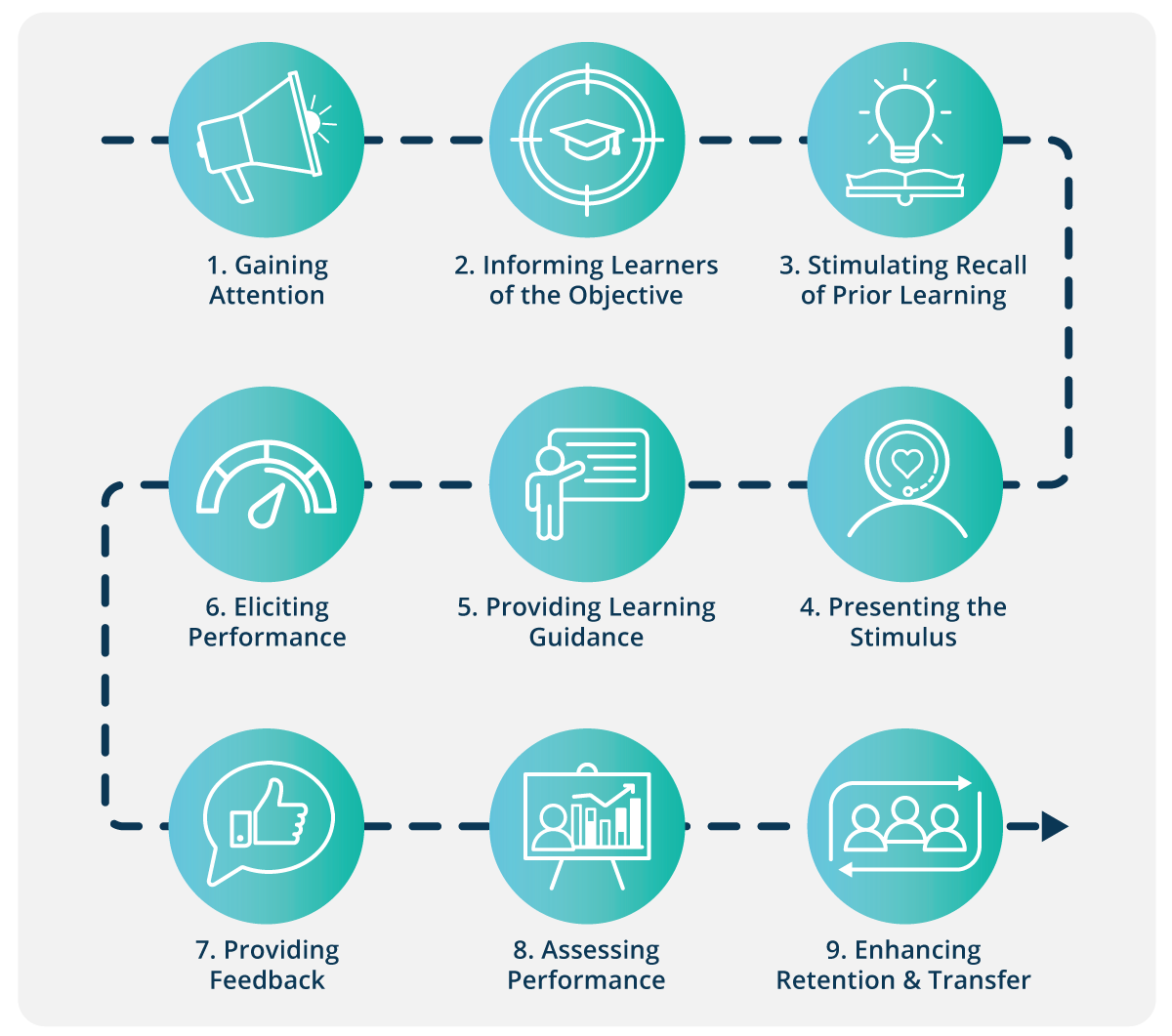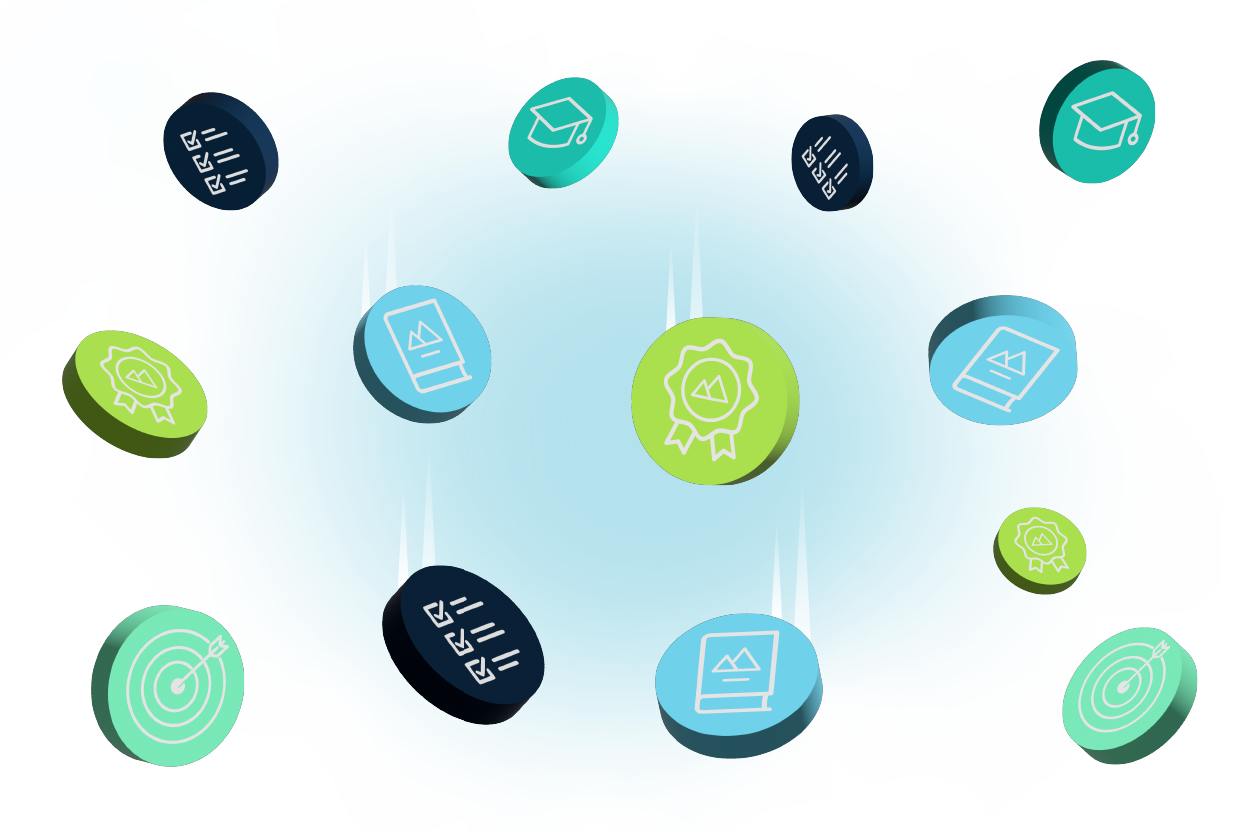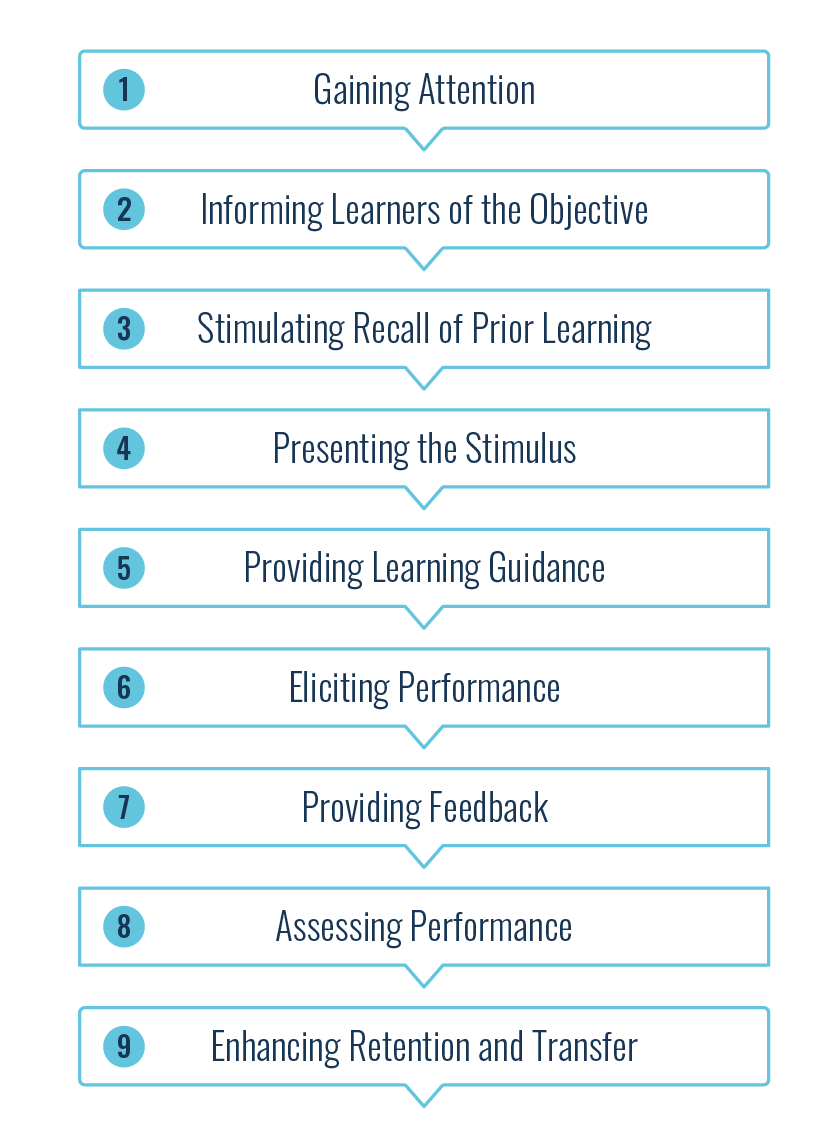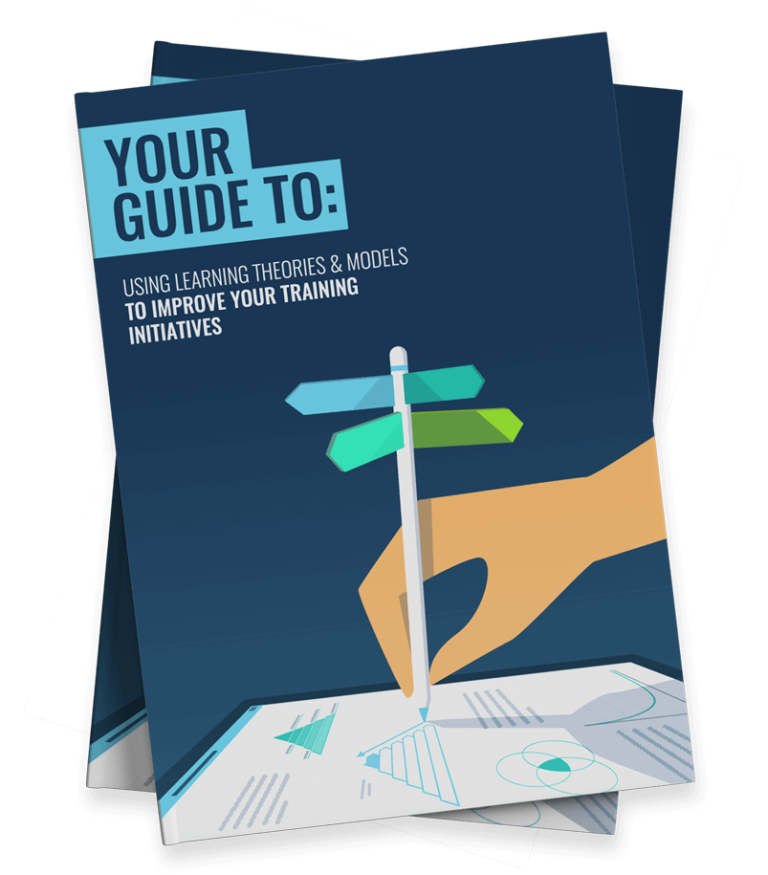
Not many can say they have changed the way humans learn, but Robert M. Gagné certainly can. His Nine Events of Instruction is a uniquely powerful framework that has been adopted by educators and trainers around the world.
This model has proven to be an effective approach for promoting deeper understanding, improved knowledge retention, and successful skill acquisition.
Gagné’s framework suggests that successful training programmes guide learners through nine distinct stages. By step nine, they will have achieved true mastery over the topic at hand.
In this article, we’ll explore Gagné’s Nine Events of Instruction in detail and review how you can apply it when training your learners online. Ready to level up your learning? Then let’s get started!
Who Was Robert Gagné?
Robert Gagné (1916 – 2002) was an American educational psychologist who helped to advance the science of instruction and learning. He began researching effective instruction whilst training pilots for the U.S. Air Corps in World War II.
He is best known for his book ‘The Conditions of Learning‘ (1965). It was in this book that he published his findings on the steps needed to promote effective learning.
Later on, Gagné applied his instructional theory to computer-based learning and investigated the role of multimedia content within training.
Gagné’s work has had a significant impact on educational psychology, instructional design and learning and development. As John H. Curry notes, ‘almost 60 years later, Gagné’s work still serves as the basic framework all instructional designers who use systematic processes follow’.
Gagné’s Nine Events of Instruction
Gagné’s Nine Events of Instruction are also known as Gagné’s Nine Conditions of Learning, Gagné’s Taxonomy of Learning, Gagné’s Nine Levels of Learning and even the Gagné Assumption. To keep things simple, we refer to the model as ‘Gagné’s Nine Events of Instruction’.

Gagné’s model revolutionised learning and development programmes and education as a whole. After his research, Gagné was able to break the learning process down into three distinct categories. He then broke these categories down further into nine events of learning:
Preparation
- Event 1: Gaining attention
- Event 2: Informing learners of the objective
- Event 3: Stimulating recall prior to learning
Instruction and Practice
- Event 4: Presenting the stimulus
- Event 5: Providing learning guidance
- Event 6: Eliciting performance
- Event 7: Providing feedback
Assessment and Transfer
- Event 8: Assessing performance
- Event 9: Enhancing retention and transfer
Gagné’s model suggests that learners move through nine stages when undergoing an instructional experience. As such, learning is not a one-off event. It’s more like a journey that takes place over time.
Educators and instructors can use these steps to maximise learning impact. For instance, you could apply the Nine Events of Instruction as follows:
| Event | Example |
|---|---|
| 1. Gain Attention | Welcome everyone, let’s get started… |
| 2. Identify Objective | Today we’re going to learn about Velociraptors… |
| 3. Recall Prior Learning | What do you remember from our previous lesson on dinosaurs? |
| 4. Present Stimulus | A Velociraptor is defined as… |
| 5. Guide Learning | Here are several line diagrams and skeletal reconstructions… |
| 6. Elicit Performance | What can you tell me about Velociraptors? |
| 7. Provide Feedback | Correct, correct, no Velociraptors were about two feet tall… |
| 8. Assess Performance | Your knowledge is good, but you should review this resource… |
| 9. Enhance Retention | Can you identify the Velociraptor from this group of dinosaurs? |
These ‘events’ can take place during a classroom training session, a single eLearning unit or even a curriculum. The key lies in ensuring that all nine steps happen across the learning journey.
Research on The Nine Events of Instruction
Unfortunately, there’s no single definitive study that proves that the Nine Events of Instruction improve learning outcomes. However, as with many other learning theories and models, research does suggest its effectiveness and it’s clearly aligned with established learning principles.
Studies have been conducted in specific contexts, such as nursing education. The study showed that ratings of instructor mastery and effectiveness improved ‘significantly’. The minimum overall lowest course grade also increased from 66% to 70%.
Another study found Gagné’s approach ‘to be a systematic strategy to improve classroom instruction across various disciplines’.
Perhaps the problem lies in the application. According to research conducted by Cynthia Higgins, subject matter experts typically only apply 50% of the nine events. How can we assess the model’s effectiveness if we’re not using it properly?
The Benefits

Gagné’s model provides us with a structured approach to instructional design. By breaking the learning process down into nine distinct events, it offers a framework for you to follow when creating your training programme.
- Clear Objectives: Each level corresponds to a specific learning objective. This ensures you have clear and well-defined instructional goals that focus on performance improvements.
- Higher Engagement: By structuring your training effectively, you can keep your learners engaged throughout the learning journey. After all, your learners will be following a structured pathway leading towards successful outcomes.
- More Variety: Each event also incorporates various instructional design elements and approaches that help you to cater to different learning styles and preferences. In addition, Gagné’s model emphasises the importance of the practical application of new knowledge.
By encouraging your learners to apply new information in realistic and relevant contexts, you can improve knowledge retention and performance. John Dewey would be proud!
Applying Gagné’s Nine Events of Instruction
Let’s explore Gagné’s Nine Events of Instruction separately to see how they could be facilitated through a modern learning programme, or by using learning technology solutions, such as an LMS or learning app.

Level 1: Gaining Attention (Reception)

➮ Level 1 Explained
WOW! BAM! POW! Did that get your attention? While this might not be the best approach, gaining attention is an essential first step for any learning process.
As such, start your training journey by ensuring your learners are with you from the get-go. Remember, our attention spans are limited, so you’re working with a finite resource.
➮ Implementing Level 1
To capture your learner’s attention, you’ll need two things: a ‘trigger’ (in the BJ Fogg sense) and a clear benefit statement. An internal marketing campaign is a good place to start. You’ll then need to keep these learners engaged.
Luckily, today’s modern learning solutions come with a wide variety of engagement tools. For example, here are a few popular attention grabbers:
- Email or Push Notifications: Looking for a trigger? You can create and send email or push notifications to drum up excitement for your upcoming training programme or as a countdown to new learning content.
- Images: The human eye can process 36,000 visual messages every hour. Visuals can even improve learning by up to 400%. As such, make sure your learning platform and eLearning content is as eye-catching as possible.
- Videos: Employees are 75% more likely to watch a video than they are to read text. This is just one of many reasons to begin your training with a video introduction.

Level 2: Informing Learners of the Objective (Expectancy)

➮ Level 2 Explained
You’ll then need to inform your learners of what to expect from their training. What objectives will you cover? What will they know at the end of the experience that they didn’t before?
Similarly, you should let them know what you expect from them as learners. This will help them set expectations and formulate their learning journey.
➮ Implementing Level 2
Answer the WIIFM (‘what’s in it for me’) question to describe what your learners will get out of the learning experience. Take care to highlight the benefits of your training programme and any associated rewards and recognition.
You can use your online learning platform to communicate with your learners. For example, Growth Engineering LMS empowers you to set up social Clubs where you can share your goals and objectives with your learners.

Level 3: Stimulating Recall of Prior Learning (Retrieval)

➮ Level 3 Explained
The next stage focuses on activating prior knowledge to facilitate learning. As we’ve seen from the forgetting curve, we forget 90% of everything we learn within a week. This retrieval process helps us to fight back and crush the curve.
Relating the topic at hand back to a similar experience your learners have had helps you to build a bridge from the old to the new. This link gives your learners a solid foundation to build on.
➮ Implementing Level 3
Effectively linking new information to prior knowledge requires a good understanding of your teams’ current skills and knowledge levels. This can be achieved through a training needs analysis (TNA).
You can also use discussion groups and workbook exercises to ask your learners to reflect upon their previous experiences. This will start the recall process and enable you to better personalise your training content.

Level 4: Presenting the Stimulus (Selective Perception)

➮ Level 4 Explained
You have gained your learner’s attention, informed them of the subject matter, and you have helped them relate to the subject. Now you’re ready to present your new content to your learners.
As such, this level focuses on sharing new information (what Gagné calls ‘the stimulus’) with your learners in an effective manner.
➮ Implementing Level 4
Presentation matters. Keep learners captivated by providing a variety of content formats. Similarly, make sure your training materials are engaging and interactive. Consider incorporating:
- Text-based content, including whitepapers, tip sheets, presentations or case studies.
- Interactive learning games and game-based content.
- Visual material, like infographics, videos or animations.
- Interactive learning opportunities using webinars, scenarios or immersive technology.

Level 5: Providing Learning Guidance (Semantic Encoding)

➮ Level 5 Explained
Now that you have delivered the content, you can’t afford to simply rest on your laurels. You have to identify and fill in any knowledge gaps that still prevail. This is the stage where you add additional context to the stimulus you’ve presented.
After all, without spaced repetition, your learners are unlikely to remember information successfully, regardless of the quality of your training materials.
➮ Implementing Level 5
Ultimately, you need to help your team learn more effectively by enabling spaced repetition and a focus on relevancy.
A great way to improve knowledge retention is by implementing scenario-based learning. This is an immersive approach where you put learners in a situation where they can make decisions and apply their knowledge in a safe environment.
Narrative-based learning is also a hugely popular way of ensuring that your content has staying power. In fact, if you weave a narrative into your learning, you’re x20 times more likely to retain the information.

Level 6: Eliciting Performance (Responding)

➮ Level 6 Explained
Do you remember at school when your teacher went around the class and asked questions based on your homework? Perhaps you were looking out the window, trying your hardest to avoid eye contact?
They were trying to ensure that you could demonstrate your knowledge of what they taught you. In fact, eliciting performance is an essential part of any training programme.
➮ Implementing Level 6
If your content teaches a new skill or process, you should ask your learners to demonstrate how to use it in real life. Role-playing exercises can help you to do this.
If your learners need to showcase their knowledge, you can create some quick-fire questions and embed them in your learning units. This way you’re testing your learners whilst they absorb your content.

Level 7: Providing Feedback (Reinforcement)

➮ Level 7 Explained
Once you have elicited performance, it’s essential that you communicate to your learners how well they did. As Ken Blanchard puts it, ‘feedback is the breakfast of champions’.
If they answered a quiz question incorrectly, then your learners need to know how they can improve. On the other hand, if they passed with flying colours, they deserve to be rewarded and encouraged.
➮ Implementing Level 7
Provide positive or negative feedback depending on your learners’ performance. Ensure that any constructive feedback points them in the right direction. Simply marking something as ‘wrong’ is insufficient.
Let them know how they can improve and provide useful resources to help fill their knowledge gaps. If you notice that learners are struggling with particular topics, then consider providing additional support.

Level 8: Assessing Performance (Retrieval)

➮ Level 8 Explained
The eighth level of Gagné’s model guides you to assess learner performance. In other words, they’ll need to prove their knowledge by completing a test or an assignment.
Your approach should enable you to evaluate your learners’ mastery of the subject at hand and whether they’ve achieved your learning objective.
➮ Implementing Level 8
You have various options when it comes to measuring performance on your digital learning tool. For instance, you could use in-unit quizzes, tests, short questionnaires, or assignments.
Looking to go beyond knowledge checks? Performance assessments (such as simulations, role-playing activities or practical demonstrations) help learners to showcase their newly acquired skills.

Level 9: Enhancing Retention and Transfer (Generalisation)

➮ Level 9 Explained
Congratulations, you’ve made it to the last stage! Gagné’s last step is to transform learners into experts, by ensuring they can effectively transfer their newfound knowledge.
Research suggests that teaching others can be an effective way to solidify our own understanding (often referred to as ‘the protégé effect‘). Encouraging your learners to apply and share their knowledge helps you to achieve this outcome.
➮ Implementing Level 9
To pull this off, you’ll need to create a high-performance learning culture fuelled by social learning. Your learners should have a place to go to interact with other team members, ask questions and share suggestions.
Not sure where to start? Live chat, social feeds, clubs and live streaming could be just the ticket. Find out more by reviewing the 8 social features you need on your learning management system.

Criticisms of The Nine Events of Instruction
The Nine Events of Instruction model, while widely used, has faced some criticism over the years. With that in mind, please consider the following points before adjusting your learning and development approach:
- Limited Flexibility: As a model, the Nine Events of Instruction is quite rigid and restrictive. This can hinder instructional design creativity and may fail to cater for diverse learners and learning contexts.
- Passive Learning: The Nine Events focus on information delivery and guided instruction. As a result, self-led learning experiences and active learning strategies may be sidelined.
- Time-consuming: Let’s not forget, this model has nine steps. Designing and implementing instruction based on all stages can be time consuming — especially for complex topics.
What’s more, there’s a lack of large-scale controlled studies that demonstrate the model’s effectiveness in improving learning outcomes. Ultimately, more robust research is required to definitively establish its impact.
Final Words

Robert Gagné’s Nine Events of Instruction helps instructional designers and learning practitioners to recognise that learning does not have to be an all-in-one experience.
Instead, think of your learning experiences as multi-stage blockbusters. This will allow you to enhance learner engagement and retention, rather than overwhelming learners with a single info-dump.
As a result, Gagné’s model has been used as a successful template for training since its conception, and it continues to influence the learning and development industry.
By marrying it with modern learning technology solutions, you can create a structured training programme that changes behaviour and impacts learner performance. Eventful learning experiences await.
Gagné’s Nine Events of Instruction is just one learning model among many. Get the full breakdown and unlock your training potential with ‘Your Guide to Learning Theories & Models‘. Download our white paper now.









